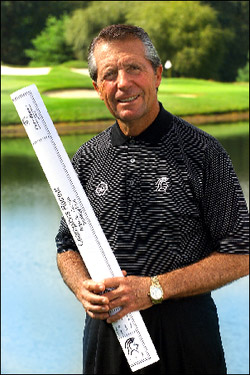
The Legend Himself
Gary Player was born in Johannesburg, South Africa, and turned professional in 1953 and is considered to be the most successful international golfer of all time. The Black Knight has won 163 tournaments worldwide including eight major championships and nine senior major championships.
Since the early 1980s, Gary Player's design firm has laid out some 40 premier golf courses throughout the United States as well as hundreds worldwide. Player emphasizes using the topography of the land "to determine how the golf course is to be laid out" and certainly our layout at Raspberry Falls was beautifully molded from its natural landscape.
Player also feels that it is "essential, when given the opportunity to design a golf course, to ensure that it is able to cater for all level of golfers. By this I mean that a course must be flexible enough to provide enjoyment for the average 15 to 20 handicap golfer, whilst also being capable of being set up for a major tournament." Raspberry Falls, with multiple tee boxes, certainly offers the chance at that kind of successful experience to all players.
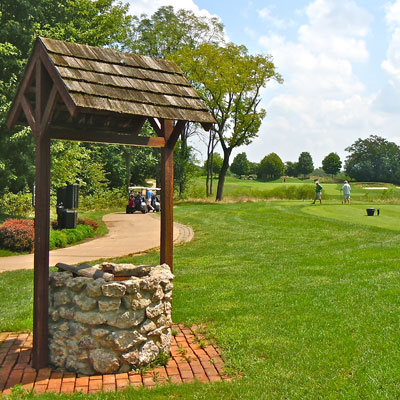
Course Overview
You need to be ready to launch your ball with authority off the first tee at our course. This hole measures 385 yards from the back and 241 from the front. "It's not a relaxing start even though this is not an overly long par-4," Pro Shop at Raspberry Falls. "There's a generous landing area, but otherwise it's uphill all the way." And just as you reach the green on this hole, you encounter "Deep Cotton," one of the first of those deep pot bunkers just to the left of the green. Here's a tip from the Pro Shop on handling the bunkers on this course: "Sometimes you'll have to hit your ball backwards or sideways."
The second hole is another strong test of golfing skills and will keep you thinking strategically. It's a par-4 again, 428 yards from the back and 300 from the forward tees. Again you're traveling mainly uphill as well as coping with a fairway that slopes from left to right toward an out-of-bounds area filled with heavy brush. "It's a hazard that will remind you of British Open courses," Pro Shop
One of the signature holes on this course is No. 3, a long par-4 playing at 479 yards from the back and 378 yards from the front. You'll greatly appreciate the views that you get from the tee box of the Catoctin Mountains and you'll also appreciate the fact that you have a downhill shot much of the way to help cut distance off this hole. "There is a tee box so that your shot drops from 60 to 100 feet," Pro Shop. "It's a long hole, but it's all downhill."
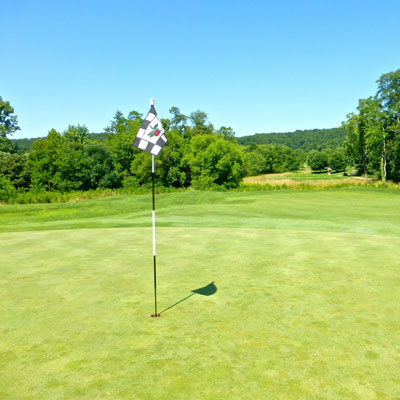
Great Design
The chief obstacle as you work your way from the generous landing area toward the green is a bunker to the right of the fairway. You'll also have to watch out for the heather-style brush as well on the sides of the fairway.
No. 4 is a reachable par-5 (549 yards from the back and 415 from the front) that takes a severe dogleg right. The key to getting to the green in two is carrying the bunkers on the right side of the fairway just off the tee. "If you can do that, you have a shot at the green," Pro Shop. "You need a good drive and then a good fairway wood."
On the front side, you'll also encounter the extremely tough test at No. 8, a par-4 playing at 443 yards from the back and 260 from the forward tees. "It's an uphill dogleg right with a pond in play for your tee shot on the righthand side," Pro Shop.
The pond, in fact, is inside the crook of the dogleg and is loaded with lost balls. It's best not to challenge the water in this case. "There's just too much of a carry going uphill," Pro Shop.
On the back nine, you face another of the toughest holes on the course on No. 10, a par-4 that plays at 462 yards from the back tees and 288 from the forward. There's a very generous landing area off the tee, but you'll also find a creek and pond on the left side. The right side is guarded by numerous fairway bunkers.
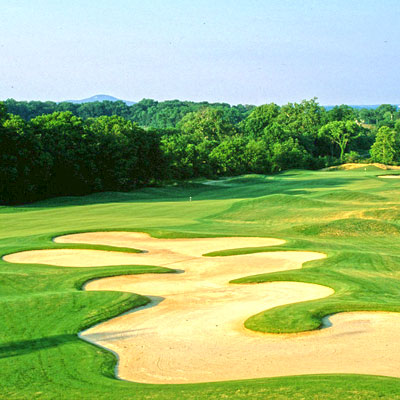
Continuing Challenge
There is a bunker here called "Hooker's Wharf," which got its name because a precise draw is your best bet for your approach shot to the green. A pond stands to the left of the green as well as that tricky pot bunkers on the front left. "If you can hit a good hook, you'll land on the green," Pro Shop.
On No. 13, you'll find an exciting par-3, measuring 184 yards from the back tees and 108 from the front. A huge pot bunker stands in the center to the front of the green, an obstacle that catches quite a few tee shots. Try to play to the left and hit to the green itself on this hole.
No. 14 is home to the notorious "Satan's Foxhole" bunker. This par-4, playing at 431 yards from the back and 292 from the forward, has a number of the bunkers on the right that can swallow your drive. Another problem is that this hole plays into the prevailing wind and is slightly uphill. The green is surrounded by bunkers as well.
After No. 15, the longest par-3 on the course, measuring 220 yards from the back and 132 from the forward tees, it's on to No. 16. This par-4 (411 yards from the back and 265 from the front) has the largest pot bunker on the course to the front-right of the green. They call this monster "Myrtle Beach," a nickname that gives you an idea of its size: 30 feet wide, 10 to 15 feet long and 12 feet deep
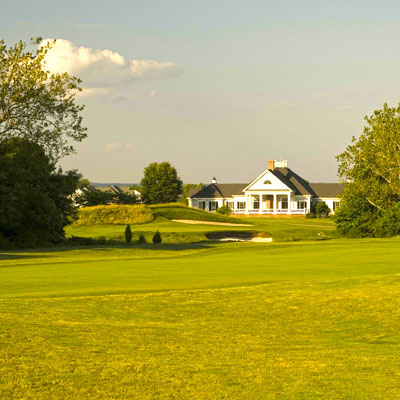
Finish Strong
No. 17, is one of the shorter par-4's, measures 369 yards from the back and 248 from the forward and is drivable for big hitters. Part of the reason why you can reach the green in two is that this is a fairly straight downhill hole. Of course trees stand to the left and a pot bunker and gorse-style brush threaten on the right. You'll also find a very deep bunker front left of the green.
The par-5 No. 18 is definitely the hole designed for the thinking golfer. This brain-teaser, measuring 550 yards from the back and 418 from the front, starts out with an elevation drop of 30 feet to the fairway. "You have to hit your drive over a creek that's going down the left side of the hole," Pro Shop. "Then on the fairway, you have to hit back over the creek toward the green. It's possible to go for it in two shots, but it's a very difficult second shot over the creek and the bunkers."
The smart players lay up in front of the creek and then make their approach shot. "It's not that difficult a hole," Pro Shop. "But you do have to play it a few times in order to know how to attack it. Your lay-up also has to be in the right place, or you can end up with a downhill lie."







